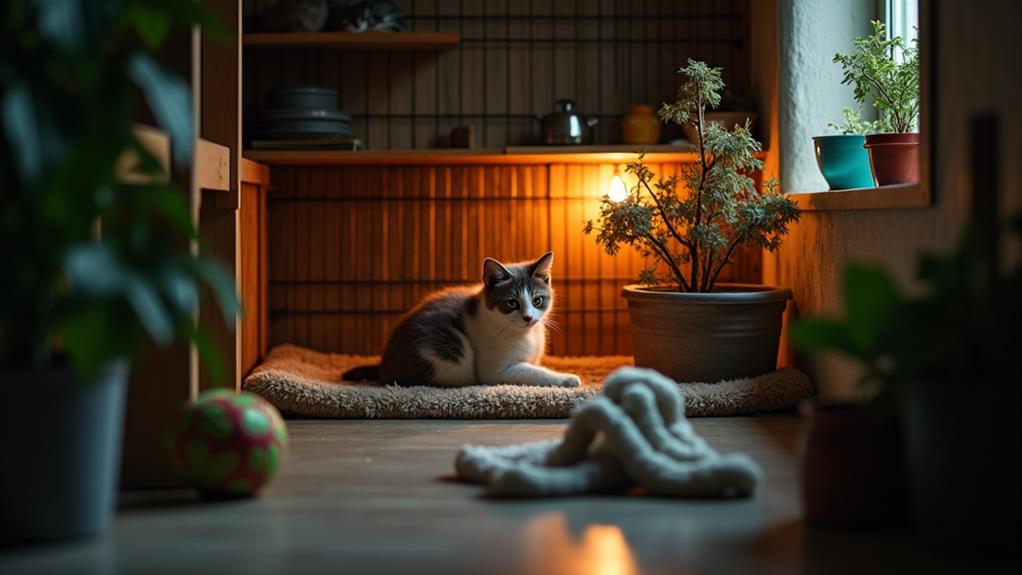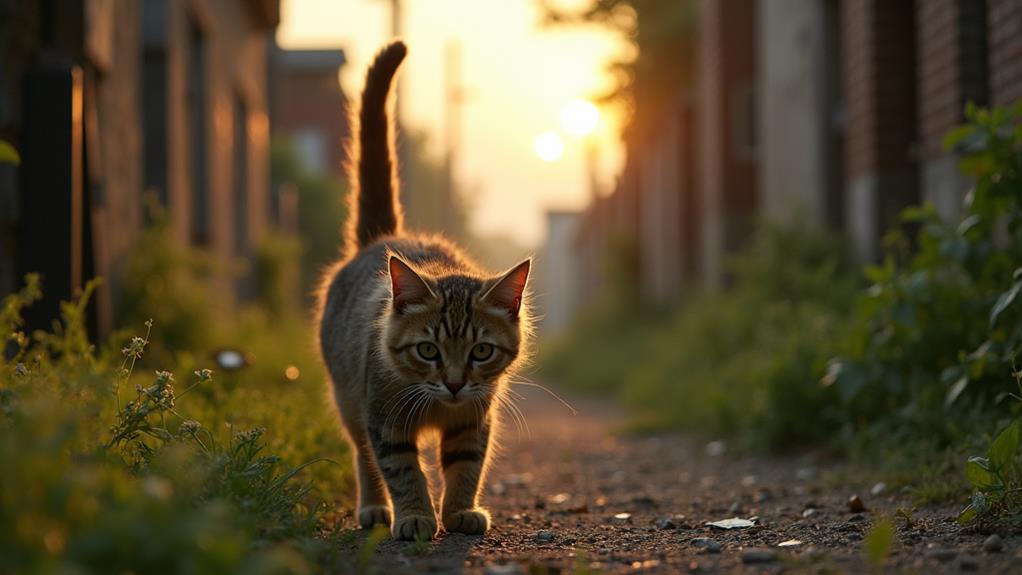How to Attract a Feral Cat to a Shelter: Creating a Safe Space

To attract a feral cat to a shelter, create a safe, inviting space tailored to their instincts. Use insulated materials like straw for warmth and guarantee the shelter has a small entrance to keep predators at bay, plus multiple exits for escapes. Raise your shelter to prevent moisture issues and place it near quiet feeding stations that share familiar scents. Maintain a consistent feeding schedule to build trust gradually. Camouflage the shelter to reduce threats and include hiding spots for comfort. Start by letting them investigate at their own pace. To uncover other subtle strategies, examine further details.
Understanding Feral Cat Behavior
Understanding feral cat behavior is vital when trying to attract them to a shelter. Feral cats are naturally wary of humans, so creating a space where they feel unthreatened is fundamental. A feeding station near the shelter can be a great way to help cats feel more at ease. By associating the area with food, you're building a positive connection, making it easier for them to approach and investigate the shelter.
To entice feral cats, consider using a cardboard box as part of your shelter setup. These boxes can serve as hiding spots, providing the security and comfort feral cats crave. Place these boxes in familiar territories where feral cats are already active. This familiarity helps them feel safer, encouraging them to examine the shelter more willingly.
Additionally, camouflage the shelter by integrating it into its surroundings. This approach helps reduce the perceived threat, making it more inviting. Be patient, as feral cats need time to adjust. Avoid forcing interactions; instead, let the cats approach at their own pace. By understanding their behavior and creating a welcoming environment, you'll increase the chances of them feeling comfortable and safe in the shelter.
Choosing the Right Shelter
Now that you've grasped how feral cats behave, it's time to focus on choosing the right shelter for them. Start by selecting insulated materials like wood composite or Styrofoam. These materials help retain warmth during colder months and prevent moisture buildup, unlike hay. A good shelter should have a small entrance, about 6-8 inches, to keep predators out while also offering a second exit for emergency escapes.
Place the shelter in a location familiar to the feral cat, ideally near their usual food and water stations. This reduces their need to travel far and increases the likelihood they'll use the shelter. Elevating the shelter 4 to 6 inches off the ground with pallets or bricks is crucial. This prevents issues like flooding, snow buildup, and contact with the cold ground, ensuring the shelter remains a dry and warm refuge.
Selecting Insulating Materials
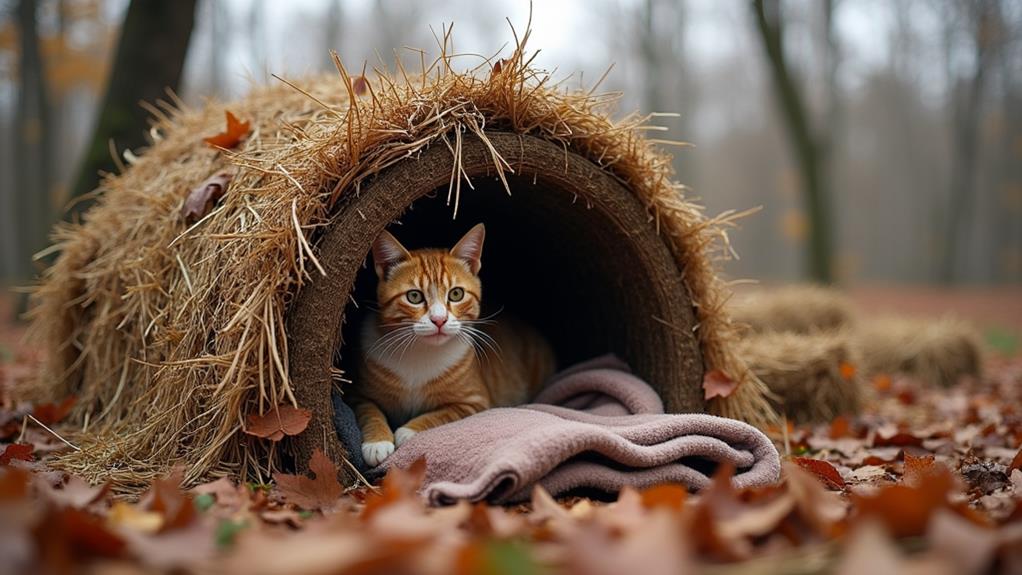
When choosing insulating materials for a feral cat shelter, many find straw to be the most effective option. Straw is dry, loose, and non-moldy, making it an ideal insulating material. Unlike hay, straw doesn't hold onto moisture, preventing dampness that could chill the cats instead of keeping them warm. It effectively traps body heat, creating a cozy environment inside the shelter. Here's a quick guide to selecting the best insulating materials:
- Straw: The top choice for insulation, providing warmth without absorbing moisture. It creates a dry, comfortable space, essential for the cats' well-being.
- Shredded Newspaper: If straw isn't available, shredded newspaper can be a viable alternative. While not as effective as straw, it offers some insulation and comfort.
- Avoid Blankets/Towels: Though tempting, blankets and towels absorb moisture, making the shelter cold and uncomfortable, defeating the purpose of insulation.
- Layer Generously: Make certain you layer a significant amount of straw to optimize insulation, helping the shelter maintain warmth and retain body heat during cold weather.
Determining Shelter Location
Choosing the right location for a feral cat shelter is crucial for the cats' safety and comfort. Start by selecting a shelter location close to the feral cat's familiar feeding spots. This minimizes their travel distance, making them feel more at ease. Community cats are more likely to use a shelter that doesn't require them to venture far from their known territory.
Look for a sheltered area, ideally near bushes or trees, which provides natural cover from harsh weather and potential predators. This natural camouflage helps the cats feel secure and protected. Raise the shelter 4 to 6 inches using pallets or bricks. This simple step prevents flooding and insulates the shelter from the cold ground during winter.
It's important to confirm the shelter isn't placed in high human traffic areas. Feral cats shy away from disturbances, so a quiet, secluded spot is best. To further blend the shelter into its surroundings, use earth-toned paint or cover it with natural materials like leaves. This camouflaging tactic helps avoid drawing unwanted attention from neighbors, confirming the cats feel safe. By carefully considering the shelter location, you're creating a welcoming haven for community cats.
Incorporating Multiple Exits
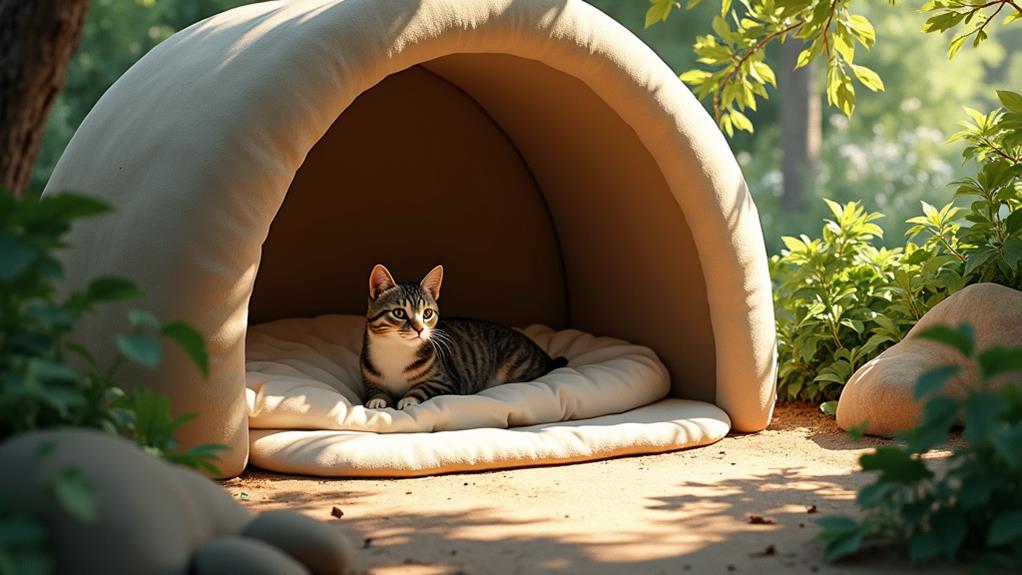
After establishing an ideal location for your feral cat shelter, focus on its design to improve safety and comfort. One significant feature is incorporating multiple exits. This guarantees the cats have escape routes when they feel threatened, a recommendation supported by the Humane Society.
Here's how to make it work:
- Position Exits on Opposite Sides: By placing two entrances on opposite sides of the cat shelter, you create ideal paths for easy escape. This reduces the risk of drafts, keeping the shelter warm and inviting.
- Limit Entrance Size: Keep each entrance between 6-8 inches. This size is perfect for cats but deters larger predators from entering, enhancing safety.
- Use Flap Doors: Install flap doors or protective entryways over the exits. They maintain warmth inside while providing a sense of security, allowing the cats to feel safe and protected.
- Exercise Patience: Remember, it might take time for feral cats to adapt to this setup. Patience is key, as this design ultimately improves their comfort and safety.
Enhancing Shelter Comfort
To improve the comfort of a feral cat shelter, focus on using materials that provide warmth and safety. Start by lining the interior with straw, which acts as excellent insulation and stays dry compared to hay. This keeps the shelter inviting and reduces the risk of mold-related health issues for the cats. Raise the shelter 4 to 6 inches off the ground using pallets or bricks. This prevents flooding and minimizes the cold from the ground, ensuring a cozy environment inside.
Design the shelter with a small entrance, about 6 to 8 inches wide, to keep predators out while allowing feral cats to feel secure. Adding a flap door can help retain warmth even further. Inside the shelter, provide different hiding spots like cardboard boxes or igloos, helping cats feel safe and reducing stress.
It's crucial to regularly check and refresh the straw bedding every 3 to 6 months to maintain cleanliness and comfort. While this section doesn't cover water bowls or feeding stations, keep in mind that their placement should complement the shelter setup, ensuring that the feral cats have a holistic, comfortable space to thrive.
Establishing Feeding Stations

When setting up feeding stations for feral cats, consistency is key to building trust and guaranteeing regular visits. By establishing a consistent feeding schedule at the same time each day, you create a sense of reliability that encourages feral cats to return. Position your feeding stations away from human disturbances and busy areas. This calm environment is essential in attracting these cautious creatures.
To guarantee the feeding station remains accessible and hygienic, consider using raised platforms. This prevents food from getting wet from rain or snow. Moreover, incorporating a protective covering helps shield the food from wildlife and the elements, while still allowing easy access for feral cats.
Regular monitoring of the feeding stations is significant. This helps maintain cleanliness and prevents food spoilage, imperative for the cats' health and for avoiding pests.
Here's how you can improve your feeding station setup:
- Consistent Feeding Schedule: Feed at the same time daily to establish trust.
- Strategic Location: Place stations in calm, low-traffic areas.
- Raised Platforms: Keep food dry and accessible.
- Protective Covering: Shield food from elements and wildlife.
With these steps, you're creating a reliable and inviting feeding station that supports feral cats' shift to a shelter.
Minimizing Stressful Stimuli
Creating a stress-free environment is vital when attracting feral cats to a shelter. Start by selecting a quiet, secluded spot for the shelter, away from high human traffic areas. This choice helps create a sense of safety and security for the cats, which is key to reducing their anxiety. Feral cats are easily spooked by loud noises, so it's necessary to shield the shelter from noise pollution. Avoid placing it near busy roads or noisy activities that could frighten them away.
Incorporate multiple hiding places and escape routes within the shelter. These features provide feral cats with the security they need to feel comfortable. Having escape routes available guarantees they won't feel trapped, which can greatly reduce their stress levels. Additionally, when you initially introduce the shelter, keep the doors open. This setup allows cats to investigate at their own pace without feeling enclosed or threatened.
Utilizing Familiar Scents
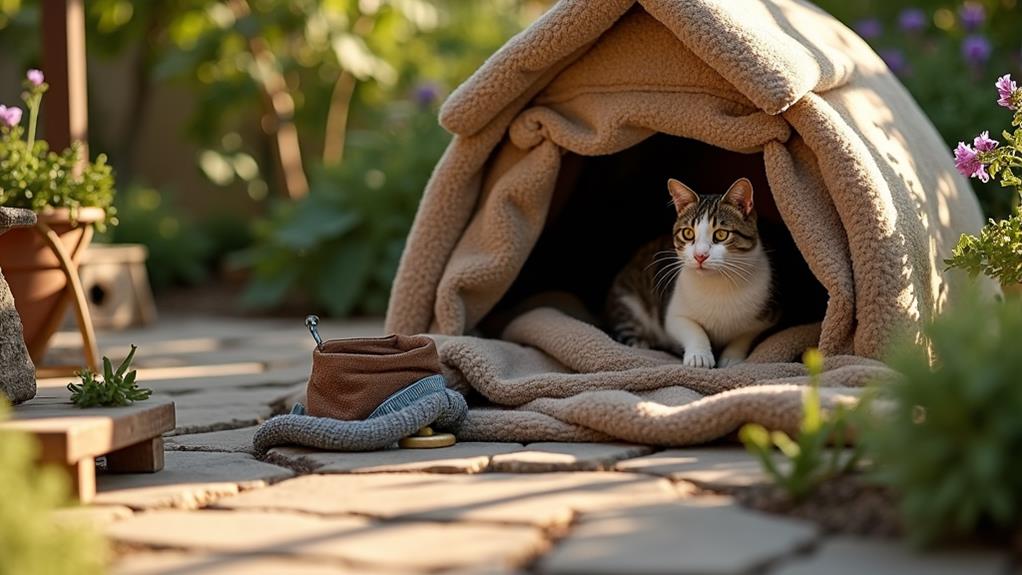
While minimizing stressful stimuli is crucial, another effective strategy involves utilizing familiar scents to attract feral cats to a shelter. By incorporating elements from a feral cat's previous environment, you can greatly reduce stress levels and encourage them to investigate their new surroundings. Familiar scents provide a sense of comfort, making the shelter feel less foreign and more inviting. Here's how you can use scents to ease their shift:
- Scattering Familiar Scents: Gather soil or plants from the cat's prior environment. Spread these around the shelter space to create a comforting and familiar atmosphere.
- Introducing Scented Items: Introduce objects that carry the scent of other cats the feral cat already knows. This can help promote a sense of acceptance and reduce anxiety about the new shelter.
- Olfactory Reassurance: Familiar scents act as olfactory reassurance. They can make the environment feel safer and more welcoming for the feral cat.
- Consistent Materials: Confirm the shelter includes materials aligned with the cat's past experiences. This consistency can facilitate a smoother shift, providing a comforting and reassuring space.
Building Trust Over Time
Trust is a delicate construct, especially regarding feral cats. To build this trust, start by positioning the shelter in a familiar area where the cat already feels safe. This location helps them associate the shelter with security, making it more inviting. Once the shelter is set, gradually introduce food nearby. Establish a consistent feeding schedule, as routine plays a significant role in encouraging feral cats to approach and investigate the shelter space.
Incorporate enticing scents such as catnip or those familiar from their previous environment to draw them closer. These scents can make the shelter seem less foreign and more like a part of their territory. Keep the shelter door open initially, allowing the cats to enter at their own pace. This approach prevents them from feeling trapped or threatened, which is essential in developing trust.
Be patient and observe their behavior closely. It's critical to give them time to acclimate to the new environment. Forcing interactions can break the fragile trust you're building, so respect their boundaries. Trust grows gradually, and with patience, you'll see them feel safe enough to enter the shelter willingly.

